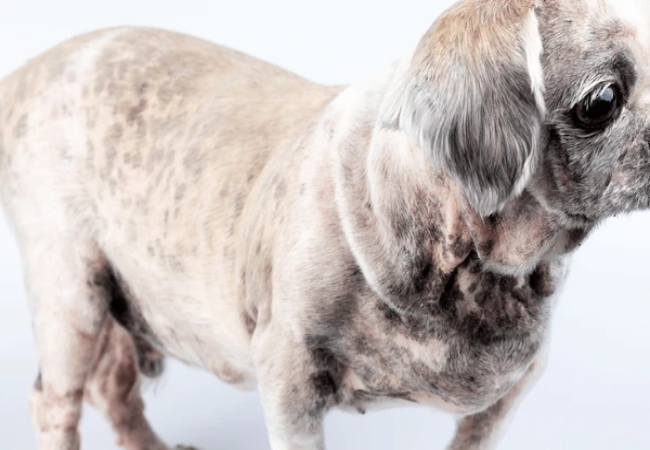Veterinary Guide to Canine Hyperpigmentation 2025 🩺🐶

In this article
Veterinary Guide to Canine Hyperpigmentation 2025 🩺🐶
By Dr. Duncan Houston BVSc
🧬 What Is Hyperpigmentation?
Hyperpigmentation occurs when a dog’s skin produces extra melanin, leading to darkened, thickened, velvety patches. These may appear light-brown to black, often in areas of friction or inflammation.
📏 Primary vs Secondary Hyperpigmentation
- Primary: Rare and breed‑specific—commonly seen in Dachshunds by age 1. It’s mostly cosmetic and non‑painful.
- Secondary: Far more common—triggered by chronic inflammation, friction, infection, allergies, or endocrine disorders.
👀 Clinical Signs
- Dark brown to black patches, rough or velvety texture, sometimes hairless.
- Commonly seen on groin, armpits, abdomen, hocks, neck, and behind the ears.
- Often accompanied by itching, redness, scaling, crusting, odor, and hair loss.
- Margins may be red, with secondary bacterial/yeast infections.
🔍 Underlying Causes
- Chronic skin inflammation: Allergies, dermatitis, hotspots, lick granuloma.
- Infections: Chronic yeast (Malassezia) or bacterial overgrowth.
- Parasites: Mites (demodex) or other parasitic infestations.
- Endocrine disorders: Hypothyroidism, Cushing’s, pseudo‑Cushing’s, lupus.
- Obesity & friction: Skin folds rubbing together.
- Sun exposure: Prolonged UV exposure increases pigmentation in exposed areas.
- Breed/genetics: Dachshunds primarily; hairless breeds, color-diluted breeds are prone to localized hyperpigmentation.
🔬 Diagnosis Workflow
- History & physical exam: Check pattern, onset, itching, weight, endocrine signs.
- Skin scrapings & cytology: Identify parasites, bacteria, and yeast.
- Allergy work-up: Food trials, intradermal testing if suspected.
- Bloodwork & endocrine testing: Thyroid panel, adrenal screening for hypothyroidism/Cushing’s.
- Skin biopsy: For atypical cases or suspected acanthosis nigricans.
🛠️ Treatment Strategies
🔹 Secondary Hyperpigmentation
- Treat infections with oral/topical antibiotics or antifungals; medicated shampoos (antibacterial/antifungal) 2–3×/week.
- Address parasites (mite treatments as needed).
- Manage allergies: hypoallergenic diet, fatty acid supplements, antihistamines, immunotherapy.
- Treat endocrine dysfunction: thyroid replacement, manage Cushing’s.
- Reduce friction: weight loss, barrier creams, and frequent grooming.
- Protect from the sun: apply dog-safe sunscreen on exposed areas.
🔹 Primary Hyperpigmentation
- Often cosmetic—no treatment needed.
- Manage secondary infections if present—with medicated washes or topical therapy.
⌛ Prognosis & Monitoring
- Depends on the cause: treat the underlying disease to improve secondary cases.
- Primary is cosmetic; rarely problematic.
- Skin color may return slowly, weeks to months post-treatment.
- Ongoing management is often needed for chronic allergies or endocrine conditions.
🏡 Home Care Tips
- Use medicated baths and leave-on products as prescribed.
- Apply emollient sprays or conditioners to maintain skin health.
- Check skin folds and pigmented areas weekly for changes.
- Monitor body weight and diet to reduce friction and inflammation.
📱 Ask A Vet Telehealth Support
- Virtual consults: Upload photos of affected areas and discuss treatment progress.
- Reminder tools: Alerts for medicated baths, treatments, and follow-up labs.
🎓 Case Spotlight: “Luna” the Pug
Luna, a 5‑year‑old Pug, developed dark, itchy patches under her arms and groin. Cytology showed yeast overgrowth, and thyroid testing revealed subclinical hypothyroidism. We treated with antifungal shampoo, started omega‑3s, and began low‑dose levothyroxine. Within two months, the pigment faded, coat regrew, and itchiness resolved—kept on track via virtual follow-up and reminder tools! 🐶💖
🔚 Key Takeaways
- Hyperpigmentation is a symptom, not a disease. Seek veterinary diagnosis.
- Primary is cosmetic; secondary requires a thorough investigation.
- Treat infections, allergies, endocrine issues, and friction to manage secondary cases.
- Remission takes time; consistency in treatment matters.
- Ask A Vet’s telehealth, reminders, nutrition tools, and care kits support healing at home. 🩺📲
Dr Duncan Houston BVSc, Ask A Vet founder. Download the Ask A Vet app today for expert remote oversight, tailored skin care routines, and ongoing support to keep your dog’s skin healthy and comfortable! 🐾❤️






